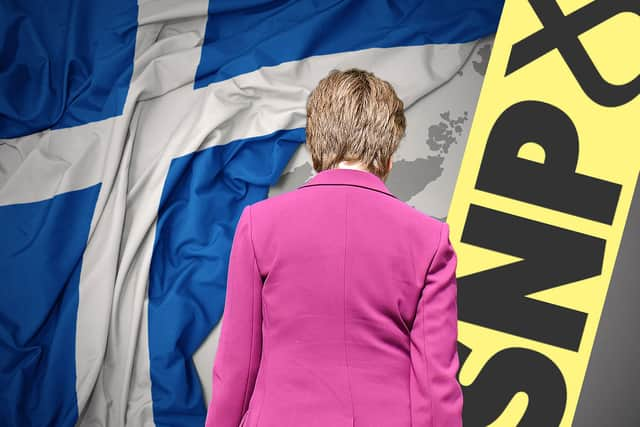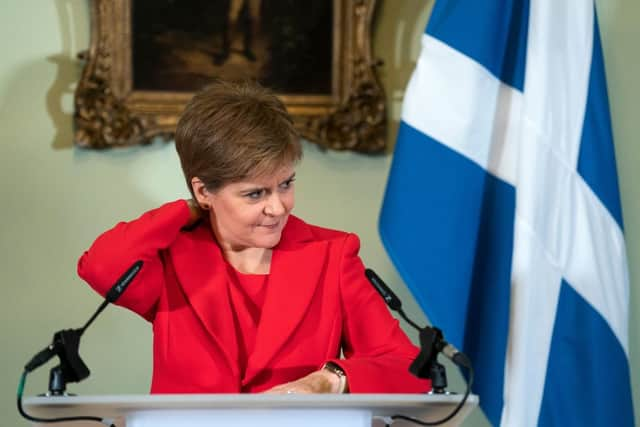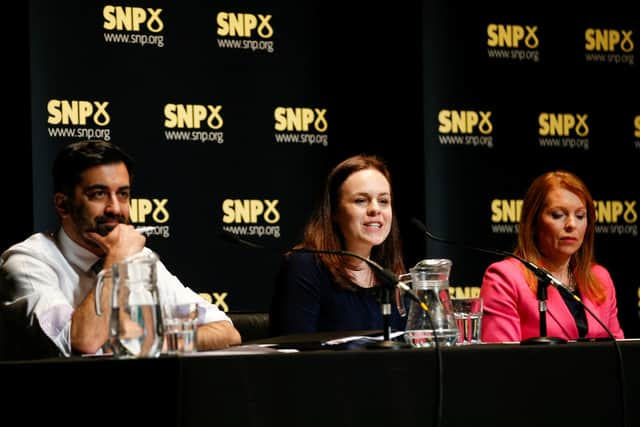Nicola Sturgeon resigns: how does Scotland elect a new SNP leader and First Minister? Voting process explained
and live on Freeview channel 276
Members of the Scottish National Party (SNP) have begun voting for which candidate they want to replace Nicola Sturgeon as both their party leader and Scotland’s First Minister.
Voting opened at noon on Monday (13 March), with Scotland’s health secretary Humza Yousaf, finance secretary Kate Forbes, and former community safety minister Ash Regan all in the running.
Advertisement
Hide AdAdvertisement
Hide AdOver the weekend, Deputy First Minister John Swinney and SNP Westminster leader Stephen Flynn both endorsed Mr Yousaf - but polling suggests that Forbes is the favourite for the top job. However, the decision is ultimately down to the 100,000 members of the SNP, who have until 27 March to cast their vote.
The snap leadership race was sparked after Nicola Sturgeon last month announced her shock resignation after eight years in power - making her the longest-serving first minister in history. Speaking at a press conference, she admitted that the “brutality” of the job had “taken its toll”. She explained: “If the question is: can I battle on for another few months? Then the answer is: yes, of course I can.
“But if the question is: can I give this job everything it demands and deserves for another year, let alone for the remainder of this parliamentary term, give it every ounce of energy that it needs in the way that I have strived to do every day for the last eight years? The answer honestly is different.”
The MSP also announced that she had instructed the SNP National Secretary - Lorna Finn - to begin the process of appointing a new leader, and confirmed that she will remain in post until a successor is elected. Because Sturgeon was elected unopposed back in 2014, the last time the SNP held a proper election was in 2004. At the time, Alex Salmond won with 75.8% of the vote.
Advertisement
Hide AdAdvertisement
Hide AdBut how exactly does it all work? Here’s everything you need to know about how Sturgeon’s successor will be chosen.


How is a new SNP leader elected?
The SNP’s constitution states that anyone who wishes to put themselves forward as a potential leader must have at least 100 nominations from party members - and that these must come from at least 20 of the party’s local branches.
If just one candidate receives sufficient nominations, they will be automatically appointed. But if there is more than one candidate, there will be an election in which all members of the SNP are eligible to vote. This will be decided on a one-person-one-vote postal voting system.
Humza Yousaf, Kate Forbes, and Ash Regan have all received sufficient nominations - so they are the names on the ballot paper. Voting opened today (13 March), and will close two weeks later, on 27 March.
Advertisement
Hide AdAdvertisement
Hide AdAccording to the SNP’s National Executive Committee, three days are usually allocated for counting before the winner is announced - meaning we are likely to hear the result on the last days of March.


How does the voting process work?
A ‘single transferable voting system’ will be used to decide the next leader of the SNP. Members will be asked to rank the three candidates in order of preference - and if a candidate secures more than 50% of first preference votes then they will be elected.
However, if this does not happen, the person in third place will be eliminated from the contest - and the second preference votes of those who voted for the eliminated candidate will be distributed amongst the two remaining candidates in order to find the winner. This means that second preferences could be key in determining the next SNP leader.
The company Mi Voice, which runs all internal SNP elections, sent out emails to party members when voting opened at noon. Paper ballots have also been sent out to those members who have requested them, with those also due to arrive on Monday (13 March).
Advertisement
Hide AdAdvertisement
Hide AdAn SNP spokesperson said: “SNP members will receive their ballots via email today and have until the morning of March 27 to cast their votes – the day the next leader will be announced. The ballot is being operated by an independent third party who will ensure the process is free, fair, and well run.”
How is a new First Minister elected?
Theoretically, any MSP could have become the next First Minister - as under section 46 of the Scotland Act 1998, when a First Minister tenders their resignation to the King, any member of the Scottish Parliament can be nominated for the role.
Nominees pitch their leadership - and MSPs are subsequently asked to cast their vote for their preferred candidate. The winner is elected on a simple majority.
However, in practice, it is usually the leader of the party with the most MSPs - which is currently the SNP - who becomes First Minister. This is what has happened on this occasion, with Yousaf, Forbes and Regan, all of whom are running in the SNP leadership race, the only MSPs up for the position.
Advertisement
Hide AdAdvertisement
Hide AdOnce results from the leadership election are verified and announced, a presiding officer will recommend to the monarch - in this case, King Charles III - that he appoints the winning candidate as First Minister of Scotland. A day or two later, the successful candidate will be sworn in at the Court of Session before appointing their ministers.


Who could Nicola Sturgeon’s successor be?
The candidates to succeed Nicola Sturgeon as leader of the SNP and as First Minister are:
- Humza Yousaf
- Kate Forbes
- Ash Regan
Yousaf has been backed by the most politicians, while Forbes is ahead in the polls. Regan is widely considered to be the outlier in the competition.
Comment Guidelines
National World encourages reader discussion on our stories. User feedback, insights and back-and-forth exchanges add a rich layer of context to reporting. Please review our Community Guidelines before commenting.
